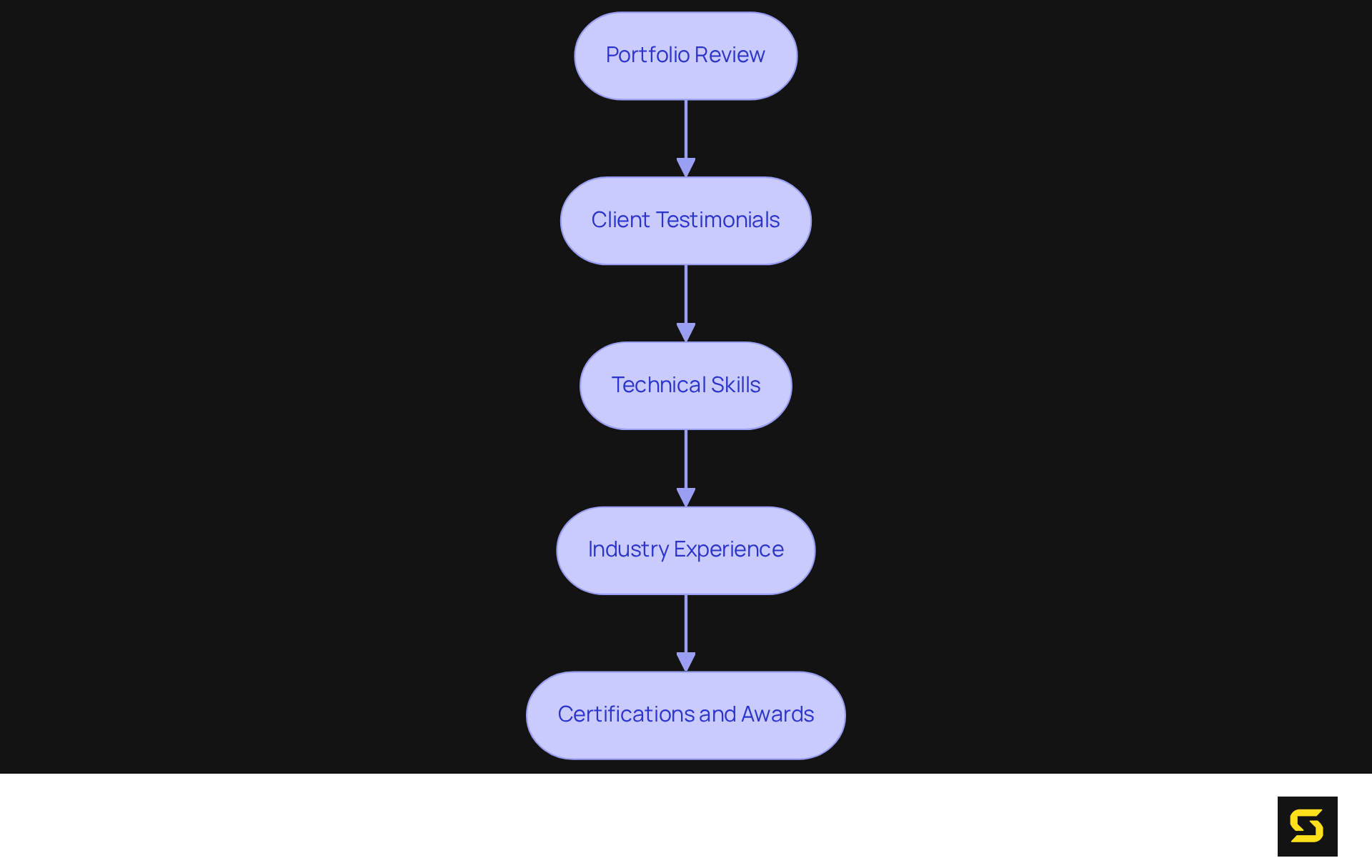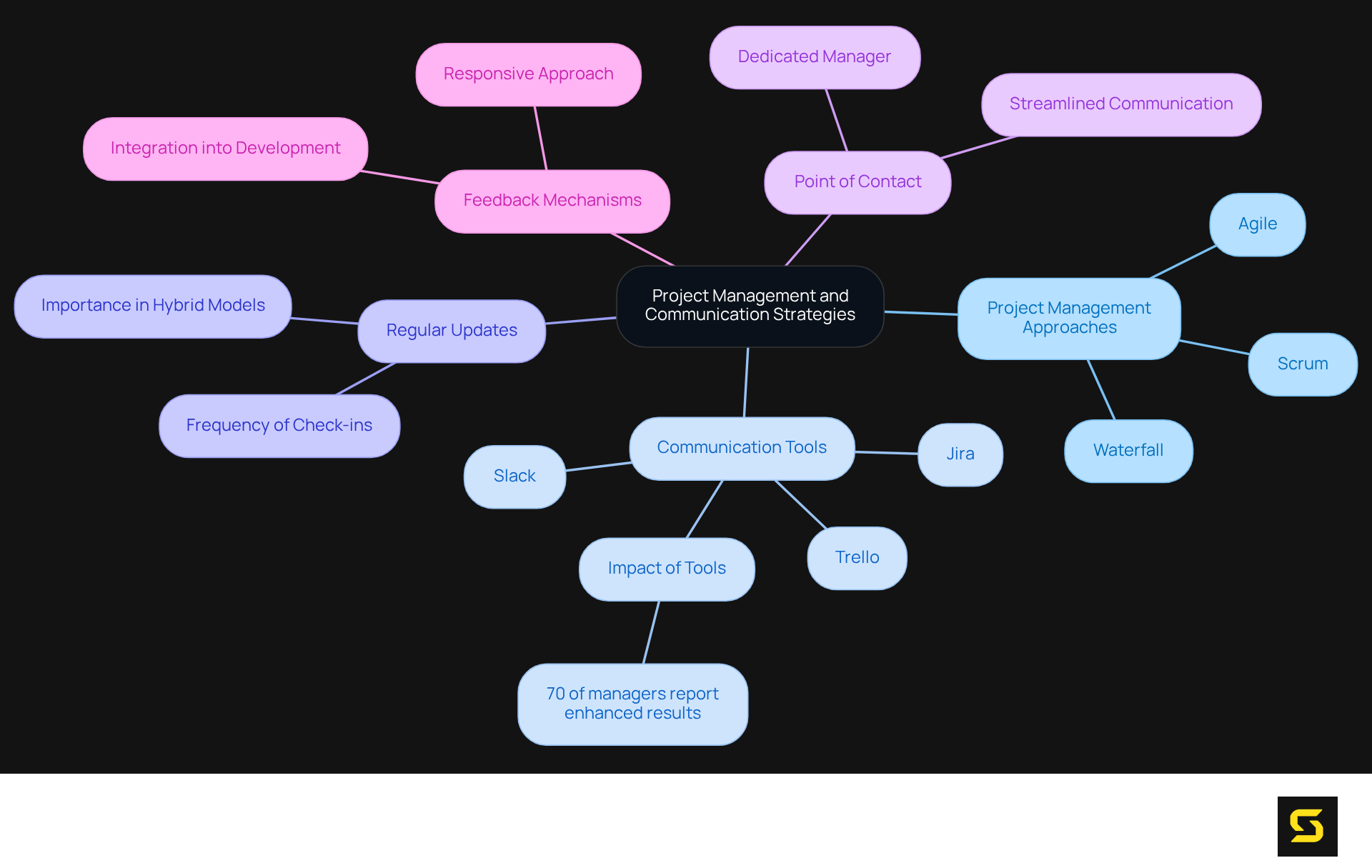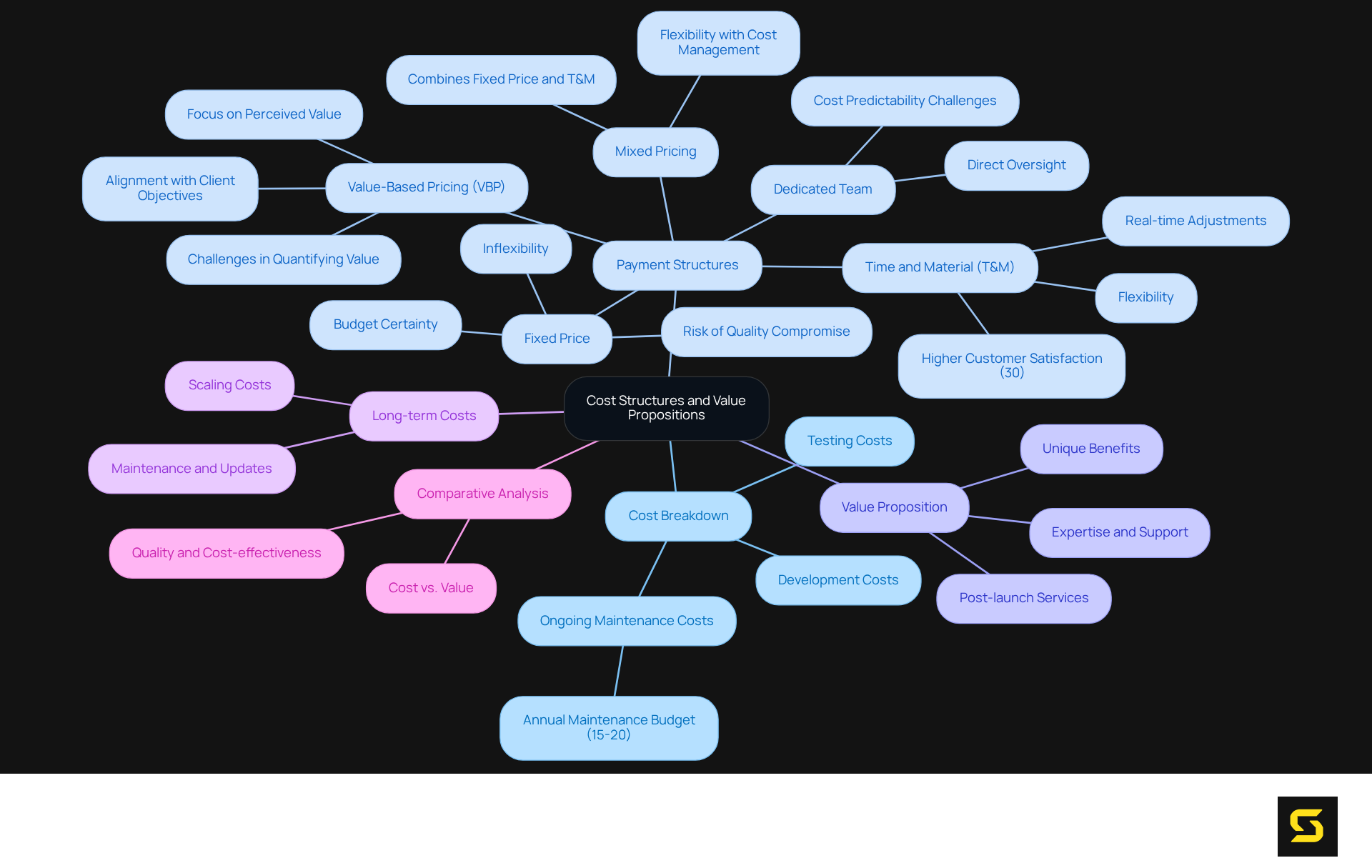Overview
Choosing the right web app development company is a critical decision that requires a strategic approach. To navigate this process effectively, one should follow four essential steps:
- Identify specific product requirements.
- Evaluate the expertise of potential firms.
- Assess their project management and communication strategies.
- Analyze cost structures alongside value propositions.
Each of these steps is crucial in ensuring that the selected company aligns with both project goals and budgetary constraints.
Begin by defining core features and understanding user needs, as these elements are fundamental to the success of your project. Next, review the technical skills of potential firms to ensure they possess the necessary expertise. Additionally, compare costs meticulously to understand the value each company brings to the table. By following these steps, you will not only make an informed choice but also set the stage for a successful partnership in web app development.
Introduction
Selecting the right web app development company presents a significant challenge, particularly in an industry characterized by high stakes and intense competition. As the SaaS landscape expands rapidly, businesses must not only pinpoint their specific needs but also secure a partner capable of fulfilling those requirements with precision. This article delineates critical steps to streamline the selection process, empowering companies to navigate the intricacies of development while optimizing their investment.
How can organizations effectively align their unique demands with the diverse offerings of potential partners to foster a successful collaboration?
Identify Your SaaS Product Requirements
-
Define Core Features: Begin by outlining the essential features your SaaS product must include. Focus on functionalities that address specific challenges faced by your target audience, ensuring that your product delivers tangible value.
-
User Personas: Understanding your end-users is crucial. Develop detailed user personas to capture their needs, preferences, and pain points. This approach not only informs product design but also enhances marketing strategies. Research indicates that B2B businesses utilizing user personas can increase website-generated leads by 97% and sales by 124%. As Shiyam Sunder, Founder of TripleDart, states, "Buyer personas enable you to tailor your marketing efforts—content, messaging, and strategies—to resonate with your target audience." Additionally, conducting user interviews and surveys is essential for gathering accurate data to inform these personas. Remember, user personas should evolve as your SaaS product matures and market conditions change, ensuring they remain relevant.
-
Technical Specifications: Clearly outline any technical requirements, including preferred programming languages, frameworks, and necessary third-party integrations. This clarity will facilitate smoother communication with potential development partners.
-
Compliance and Security: Identify any industry-specific regulations or security standards your application must meet, particularly in sensitive sectors like healthcare or finance. Ensuring compliance is vital for building trust and safeguarding user data.
-
Budget and Timeline: Establish a preliminary budget and timeline for your endeavor. This framework will guide your conversations with potential web app development companies, helping to align expectations and resources efficiently.

Evaluate Expertise in SaaS Development
-
Portfolio Review: Evaluate the portfolios of potential firms to examine their past SaaS projects. Seek diversity in their work and ensure it aligns with your specific needs.
-
Client Testimonials: Investigate reviews and testimonials from former clients to gauge satisfaction levels and the organization’s ability to adhere to deadlines and budgets.
-
Technical Skills: Confirm that the organization possesses expertise in the technologies you intend to utilize. Inquire about their experience with specific programming languages and frameworks pertinent to your project.
-
Industry Experience: Assess whether the organization has relevant experience in your industry. Familiarity with industry-specific challenges can provide a significant competitive edge.
-
Certifications and Awards: Identify any pertinent certifications or awards that highlight the organization’s commitment to quality and excellence in software development.

Assess Project Management and Communication Strategies
-
Project Management Approaches: Inquire about the management approaches employed by the organization, such as Agile, Scrum, or Waterfall. Selecting a web app development company that aligns with your preferred approach is essential for ensuring seamless collaboration.
-
Communication Tools: Ask about the communication and task tracking tools they utilize, including widely recognized options like Slack, Trello, and Jira. Proficiency with tools you are comfortable using is crucial, as effective communication serves as a cornerstone of successful SaaS initiatives. Notably, statistics indicate that 70% of managers report enhanced results after integrating effective communication tools into their workflows, underscoring the importance of these tools in driving positive outcomes.
-
Regular Updates: Discuss the frequency of progress updates concerning the initiative. Regular check-ins are vital for maintaining momentum and facilitating timely adjustments, significantly improving results. In the context of hybrid work models, consistent communication becomes even more critical to ensure all team members remain aligned and informed.
-
Point of Contact: Identify your primary point of contact throughout the project. A dedicated manager can streamline communication and ensure accountability, simplifying the process of addressing any issues that may arise.
-
Feedback Mechanisms: Understand how the company integrates feedback into their development process. A responsive approach to feedback is essential for iterative improvement in a web app development company, ensuring that the final product aligns with your vision and requirements. Highlighting collaboration and responsiveness in feedback mechanisms resonates well with agile methodologies, fostering a culture of continuous enhancement.

Analyze Cost Structures and Value Propositions
-
Cost Breakdown: Request a detailed breakdown of costs related to your endeavor, including development, testing, and ongoing maintenance. This transparency is crucial in understanding where your money is allocated.
-
Payment Structures: Understanding the various payment structures available is essential for aligning your financial strategy with project requirements. The primary models include:
- Fixed Price: This model is ideal for projects with well-defined scopes and clear requirements, offering budget certainty. However, it can be inflexible, making it difficult to adapt to changes, which may result in delays or quality compromises.
- Time and Material (T&M): Suitable for projects with evolving requirements, T&M offers flexibility as clients are billed based on actual hours worked. This framework fosters a collaborative environment, allowing real-time adjustments based on user feedback or market dynamics. T&M projects have shown a 30% higher customer satisfaction rate due to improved transparency and communication.
- Value-Based Pricing (VBP): This approach focuses on the perceived value delivered to customers rather than just the cost of time and materials. VBP aligns the interests of development teams and clients, motivating developers to exceed expectations. Implementing VBP necessitates a profound understanding of the customer's business objectives and the potential impact of the software solution. However, accurately quantifying the value a software solution can provide can be challenging, particularly in complex projects.
- Dedicated Team: This model provides significant control over the development team, allowing clients to directly oversee team members. While it offers flexibility, predicting the final cost can be difficult due to hourly rates.
- Mixed Pricing: Combining elements of both fixed price and T&M, this model facilitates scope changes while managing costs. It is particularly advantageous for projects with ambiguous requirements that require rapid deployment.
-
Value Proposition: Evaluate the value proposition of the web app development company. What unique benefits do they provide that justify their pricing? Consider factors such as expertise, support, and post-launch services. Companies that implement innovative pricing strategies, like VBP, often partner with a web app development company to deliver enhanced value through tailored solutions that address specific client needs.
-
Long-term Costs: Assess the long-term expenses associated with the initiative, including maintenance, updates, and potential scaling. It is advisable to budget for ongoing maintenance costs of 15 to 20 percent of the initial development budget annually to ensure security and compatibility. As industry experts recommend, businesses should factor in these ongoing expenses to sustain operational efficiency.
-
Comparative Analysis: Compare the costs and value propositions of multiple companies to pinpoint the best fit for your endeavor. Strive for a balance between quality and cost-effectiveness, ensuring that the chosen payment model aligns with your initiative's complexity and your organization's financial strategy. Understanding software pricing strategies is vital for project success and alignment with industry trends.

Conclusion
Selecting the right web app development company is an essential step in ensuring the success of a SaaS product. By meticulously considering your specific requirements, evaluating the expertise of potential partners, and analyzing their project management strategies and cost structures, organizations can make informed decisions that align with their goals and budget. This thorough process not only streamlines development but also enhances the likelihood of delivering a product that effectively meets user needs.
The article delineates several crucial steps to guide this selection process. It underscores the importance of:
- Defining core features and user personas
- Ensuring technical specifications are clear
- Recognizing compliance and security needs
Furthermore, assessing the development company’s portfolio, client testimonials, and industry experience provides invaluable insights into their capabilities. Effective communication and project management strategies play a significant role in fostering collaboration and achieving desired outcomes. Lastly, understanding various cost structures and the value propositions offered by development firms aids in making cost-effective choices that do not compromise quality.
In conclusion, the journey of selecting a web app development company is multifaceted and demands a strategic approach. By adhering to these outlined steps, businesses can not only identify a development partner that meets their specific needs but also lay the groundwork for a successful and sustainable SaaS product. Investing time and effort into this selection process is imperative, as the right partnership can profoundly influence the overall success and growth of your application in an ever-competitive market.
Frequently Asked Questions
What are the first steps in identifying SaaS product requirements?
Begin by defining core features that your SaaS product must include, focusing on functionalities that address specific challenges faced by your target audience.
Why are user personas important in developing a SaaS product?
User personas are crucial as they help capture the needs, preferences, and pain points of end-users. This understanding informs product design and enhances marketing strategies, leading to increased leads and sales.
How can businesses effectively create user personas?
Businesses can create effective user personas by conducting user interviews and surveys to gather accurate data. It's also important that these personas evolve as the SaaS product matures and market conditions change.
What technical specifications should be outlined for a SaaS product?
Clearly outline technical requirements such as preferred programming languages, frameworks, and necessary third-party integrations to facilitate smoother communication with potential development partners.
What compliance and security considerations should be taken into account?
Identify any industry-specific regulations or security standards that the application must meet, especially in sensitive sectors like healthcare or finance, to build trust and safeguard user data.
How should budget and timeline be established for developing a SaaS product?
Establish a preliminary budget and timeline to guide conversations with potential web app development companies, helping to align expectations and resources effectively.





